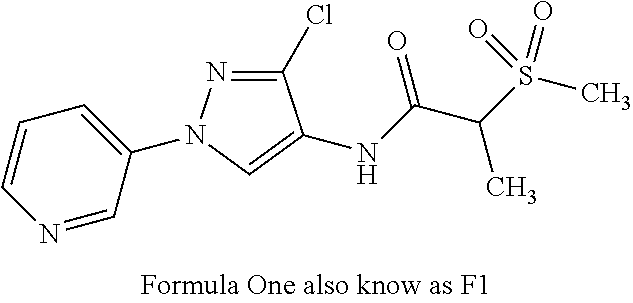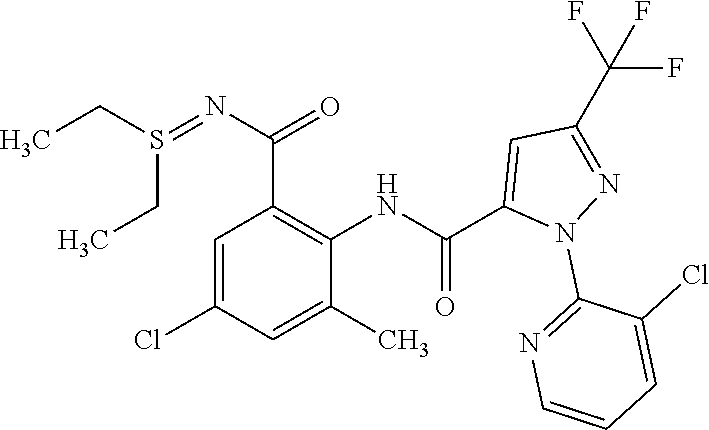Molecule having pesticidal utility, and compositions, and processes, related thereto
a technology of pesticidal utility and molecules, applied in the field of molecules having pesticidal utility, can solve the problems of destroying more than 40% of all food production, prone to loss, and often one of the most insidious and costly problems
- Summary
- Abstract
- Description
- Claims
- Application Information
AI Technical Summary
Benefits of technology
Problems solved by technology
Method used
Image
Examples
example 1
on of 3-chloro-1-(pyridin-3-yl)-1H-pyrazol-4-amine (C5)
[0096]
[0097]Step 1—Preparation of 3-chloro-1H-pyrazol-4-amine hydrochloride (C2): A 2 liter (L) three-necked round bottom flask was affixed with an overhead stirrer, a temperature probe, an addition funnel, and a nitrogen inlet. Into this three-necked flask were added ethanol (600 milliliters (mL)) and 4-nitro-1H-pyrazole (C1; 50.6 grams (g), 447 millimoles (mmol)). To this solution was added, in one portion, concentrated hydrochloric acid (HCl; 368 mL) (note: rapid exotherm from 15° C. to 39° C.), and the resulting mixture was purged with nitrogen (N2) for 5 minutes (min). Palladium on alumina (5% w / w) (2.6 g) was added, and the mixture was stirred at room temperature while triethylsilane (208 g, 1789 mmol) was added drop-wise over 4 hours (h). The reaction mixture, which started to self-heat slowly from 35° C. to 55° C. over 2 h, was stirred for a total of 16 h. The mixture was vacuum filtered through a plug of Celite®, and a ...
example 2
on of N-(3-chloro-1-(pyridin-3-yl)-1H-pyrazol-4-yl)-2-(methylsulfonyl)propanamide (Formula One)
[0101]
[0102]Step 1—Preparation of N-(3-chloro-1-(pyridin-3-yl)-1H-pyrazol-4-yl)-2-(methylthio)propanamide (C7): To a suspension of 3-chloro-1-(pyridin-3-yl)-1H-pyrazol-4-amine (C5; 0.1 g, 0.514 mmol) and 2-(methylthio)propanoic acid (C6; 0.185 g, 1.541 mmol) in DCM (1.713 mL) were added sequentially N,N-dimethylpyridin-4-amine (0.220 g, 1.798 mmol) and N1-((ethylimino)methylene)-N3,N3-dimethylpropane-1,3-diamine hydrochloride (0.305 g, 1.593 mmol). The reaction mixture was stirred at ambient temperature for 18 h and was concentrated. Purification by silica gel chromatography (0-100% EtOAc / hexanes) gave the title compound as a white solid (116 mg, 72%): mp 129-132° C.; 1H NMR (400 MHz, CDCl3) δ 8.98 (d, J=2.4 Hz, 1H), 8.63 (s, 1H), 8.58-8.53 (m, 1H), 8.03-7.96 (m, 1H), 7.43-7.37 (m, 1H), 3.59-3.48 (m, 1H), 2.18 (s, 3H), 1.59 (d, J=7.3 Hz, 3H); ESIMS m / z 297 ([M+1]+).
[0103]Step 2—Preparation...
example 3
on of 3-chloro-N-methyl-1-(pyridin-3-yl)-1H-pyrazol-4-amine (C9)
[0104]
[0105]Step 1—Preparation of tert-butyl (3-chloro-1-(pyridin-3-yl)-1H-pyrazol-4-yl)(methyl)carbamate (C8): To a solution of tert-butyl 3-chloro-1-(pyridin-3-yl)-1H-pyrazol-4-ylcarbamate (C4; 1.0 g, 3.39 mmol) in N,N-dimethylformamide (16.96 mL) at 0° C. was added sodium hydride (0.163 g, 4.07 mmol). After 30 min the flask was warmed to ambient temperature and the reaction mixture was stirred for another 30 min. Iodomethane (0.232 mL, 3.73 mmol) was added to the flask, and the reaction mixture was stirred at ambient temperature for 2 h. The reaction was quenched by adding saturated ammonium chloride. The reaction mixture was extracted twice with tert-butyl methyl ether. The organic layer was dried over sodium sulfate, filtered and concentrated. Purification via silica column chromatography (0-100% EtOAc / hexanes) gave the title compound as a yellow oil (983 mg, 94%): 1H NMR (400 MHz, CDCl3) δ 8.91 (d, J=2.5 Hz, 1H), ...
PUM
 Login to View More
Login to View More Abstract
Description
Claims
Application Information
 Login to View More
Login to View More - R&D
- Intellectual Property
- Life Sciences
- Materials
- Tech Scout
- Unparalleled Data Quality
- Higher Quality Content
- 60% Fewer Hallucinations
Browse by: Latest US Patents, China's latest patents, Technical Efficacy Thesaurus, Application Domain, Technology Topic, Popular Technical Reports.
© 2025 PatSnap. All rights reserved.Legal|Privacy policy|Modern Slavery Act Transparency Statement|Sitemap|About US| Contact US: help@patsnap.com



